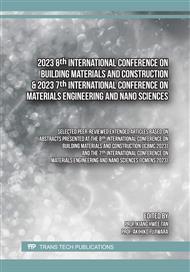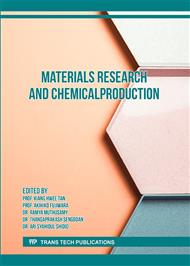[1]
R. Borah, F. R. Hughson, J. Johnston, and T. Nann, "On battery materials and methods," Materials Today Advances, vol. 6. Elsevier Ltd, Jun. 01, 2020.
DOI: 10.1016/j.mtadv.2019.100046
Google Scholar
[2]
M. A. Azam, N. E. Safie, A. S. Ahmad, N. A. Yuza, and N. S. A. Zulkifli, "Recent advances of silicon, carbon composites and tin oxide as new anode materials for lithium-ion battery: A comprehensive review," Journal of Energy Storage, vol. 33. Elsevier Ltd, Jan. 01, 2021.
DOI: 10.1016/j.est.2020.102096
Google Scholar
[3]
C.-H. Yim, S. Niketic, N. Salem, O. Naboka, and Y. Abu-Lebdeh, "Towards Improving the Practical Energy Density of Li-Ion Batteries: Optimization and Evaluation of Silicon:Graphite Composites in Full Cells," J Electrochem Soc, vol. 164, no. 1, pp. A6294–A6302, 2017.
DOI: 10.1149/2.0481701jes
Google Scholar
[4]
A. Casimir, H. Zhang, O. Ogoke, J. C. Amine, J. Lu, and G. Wu, "Silicon-based anodes for lithium-ion batteries: Effectiveness of materials synthesis and electrode preparation," Nano Energy, vol. 27. Elsevier Ltd, p.359–376, Sep. 01, 2016.
DOI: 10.1016/j.nanoen.2016.07.023
Google Scholar
[5]
M. N. Obrovac and L. Christensen, "Structural changes in silicon anodes during lithium insertion/extraction," Electrochemical and Solid-State Letters, vol. 7, no. 5, 2004.
DOI: 10.1149/1.1652421
Google Scholar
[6]
C. Zhang, "Review-Recent development on silicon-based anodes for high-performance Lithium-Ion Batteries," in E3S Web of Conferences, Apr. 2021, vol. 252.
DOI: 10.1051/e3sconf/202125203004
Google Scholar
[7]
C. Zhang et al., "Challenges and Recent Progress on Silicon‐Based Anode Materials for Next‐Generation Lithium‐Ion Batteries," Small Struct, vol. 2, no. 6, p.2100009, Jun. 2021.
DOI: 10.1002/sstr.202100009
Google Scholar
[8]
M. Yoshio, T. Tsumura, and N. Dimov, "Electrochemical behaviors of silicon based anode material," in Journal of Power Sources, Aug. 2005, vol. 146, no. 1–2, p.10–14.
DOI: 10.1016/j.jpowsour.2005.03.143
Google Scholar
[9]
Q. H. Nguyen, I. T. Kim, and J. Hur, "Core-shell Si@c-PAN particles deposited on graphite as promising anode for lithium-ion batteries," Electrochim Acta, vol. 297, p.355–364, Feb. 2019.
DOI: 10.1016/j.electacta.2018.12.005
Google Scholar
[10]
J. Sourice et al., "Core-shell amorphous silicon-carbon nanoparticles for high performance anodes in lithium ion batteries," J Power Sources, vol. 328, p.527–535, Oct. 2016.
DOI: 10.1016/j.jpowsour.2016.08.057
Google Scholar
[11]
S. H. Ng, J. Wang, D. Wexler, S. Y. Chew, and H. K. Liu, "Amorphous carbon-coated silicon nanocomposites: A low-temperature synthesis via spray pyrolysis and their application as high-capacity anodes for lithium-ion batteries," Journal of Physical Chemistry C, vol. 111, no. 29, p.11131–11138, Jul. 2007.
DOI: 10.1021/jp072778d
Google Scholar
[12]
Q. Pan et al., "Micro-sized spherical silicon@carbon@graphene prepared by spray drying as anode material for lithium-ion batteries," J Alloys Compd, vol. 723, p.434–440, Nov. 2017.
DOI: 10.1016/j.jallcom.2017.06.217
Google Scholar
[13]
J. Qin et al., "High rate capability and long cycling life of graphene-coated silicon composite anodes for lithium ion batteries," Electrochim Acta, vol. 256, p.259–266, Dec. 2017.
DOI: 10.1016/j.electacta.2017.10.022
Google Scholar
[14]
C. C. Hsieh and W. R. Liu, "Carbon-coated Si particles binding with few-layered graphene via a liquid exfoliation process as potential anode materials for lithium-ion batteries," Surf Coat Technol, vol. 387, Apr. 2020.
DOI: 10.1016/j.surfcoat.2020.125553
Google Scholar
[15]
Y. Liu, K. Hanai, J. Yang, N. Imanishi, A. Hirano, and Y. Takeda, "Silicon/carbon composites as anode materials for li-ion batteries," Electrochemical and Solid-State Letters, vol. 7, no. 10, 2004.
DOI: 10.1149/1.1795031
Google Scholar
[16]
S. Casino et al., "Al2O3 protective coating on silicon thin film electrodes and its effect on the aging mechanisms of lithium metal and lithium-ion cells," J Energy Storage, vol. 44, Dec. 2021.
DOI: 10.1016/j.est.2021.103479
Google Scholar
[17]
H. S. Sitinamaluwa et al., "Nanoporous SiOx coated amorphous silicon anode material with robust mechanical behavior for high-performance rechargeable Li-ion batteries," Nano Materials Science, vol. 1, no. 1, p.70–76, Mar. 2019.
DOI: 10.1016/j.nanoms.2019.02.005
Google Scholar
[18]
M. J. Osiak, E. Armstrong, T. Kennedy, C. M. Sotomayor Torres, K. M. Ryan, and C. O'Dwyer, "Core-shell tin oxide, indium oxide, and indium tin oxide nanoparticles on silicon with tunable dispersion: Electrochemical and structural characteristics as a hybrid Li-ion battery anode," ACS Appl Mater Interfaces, vol. 5, no. 16, p.8195–8202, Aug. 2013.
DOI: 10.1021/am4023169
Google Scholar
[19]
X. W. Jiao, Y. H. Tian, and X. J. Zhang, "Hollow Si nanospheres with amorphous TiO2 layer used as anode for high-performance Li-ion battery," Appl Surf Sci, vol. 566, Nov. 2021.
DOI: 10.1016/j.apsusc.2021.150682
Google Scholar
[20]
M. Ding, J. Zhai, P. Zeng, C. Zhang, and Y. Ping, "Introduction of amorphous TiO2 coating layer to improve the lithium storage of SiO2 nanospheres anode," Ionics (Kiel), vol. 28, no. 3, p.1081–1089, Mar. 2022.
DOI: 10.1007/s11581-021-04435-w
Google Scholar
[21]
J. Soo Kim, S. Jung Kim, E. Gu Jung, H. Hui Yun, and S. Man Koo, "Ceramic Processing Research The Preparation of Titania Nano Crystals and Silica-Titania Core-Shell Particles through Peptization Process," 2013.
Google Scholar
[22]
D. Xu et al., "Amorphous TiO2 layer on silicon monoxide nanoparticles as stable and scalable core-shell anode materials for high performance lithium-ion batteries," Appl Surf Sci, vol. 479, p.980–988, Jun. 2019.
DOI: 10.1016/j.apsusc.2019.02.156
Google Scholar
[23]
M. Ding, X. Miao, L. Cao, C. Zhang, and Y. Ping, "Core-shell nanostructured SiO2@a-TiO2@Ag composite with high capacity and safety for Li-ion battery anode," Mater Lett, vol. 308, Feb. 2022.
DOI: 10.1016/j.matlet.2021.131276
Google Scholar
[24]
J. Yang et al., "Amorphous TiO2 shells: A vital elastic buffering layer on silicon nanoparticles for high performance and safe lithium storage," Advanced Materials, vol. 29, no. 48, Dec, 2017.
DOI: 10.1002/adma.201700523
Google Scholar



